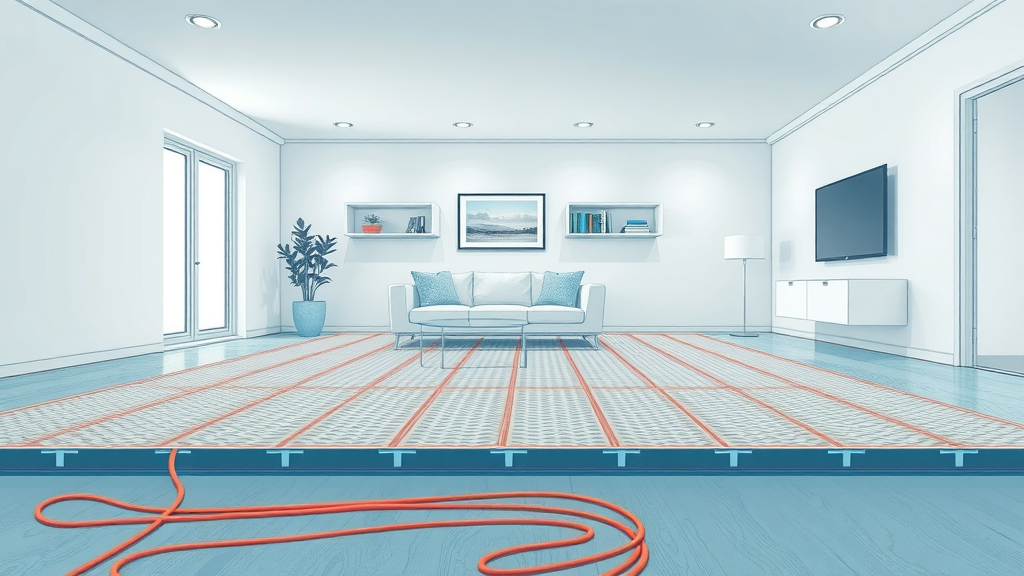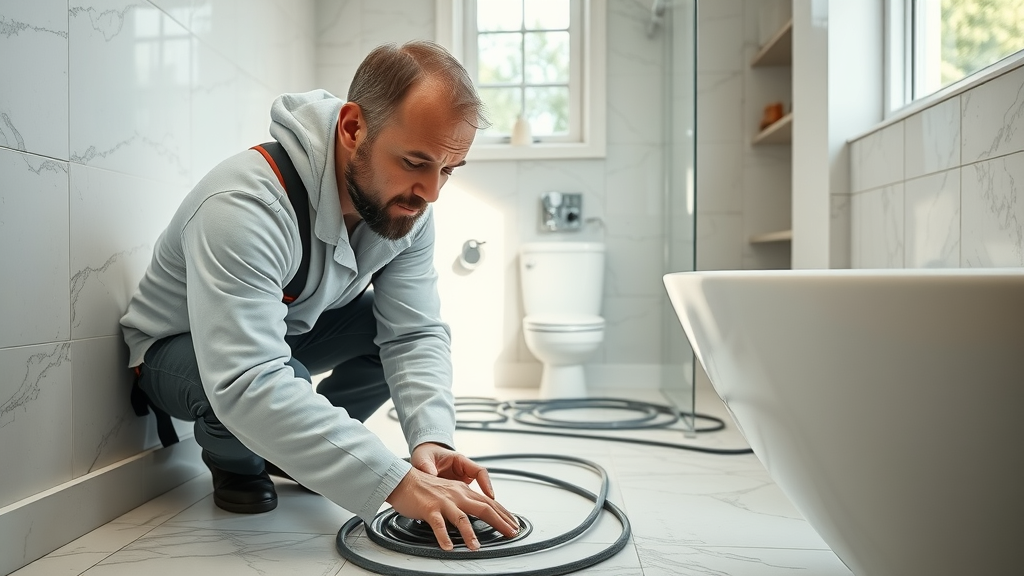Did you know that over 40% of newly built residential properties in the UK now install some form of underfloor heating? This remarkable statistic signals a dramatic shift in home heating preferences. As energy costs continue to rise and homeowners demand greater comfort and efficiency, electric underfloor heating systems are quickly taking centre stage. But what makes them so appealing? Are there downsides you should be aware of before making a decision? This article dives deep into both the pros and cons of electric underfloor heating, giving you everything you need to decide if this modern solution is the right investment for your home.
Revealing the Truth: Why Electric Underfloor Heating Systems Are Gaining Popularity
"Over 40% of newly built residential properties in the UK now install some form of underfloor heating – a clear signal of shifting preferences, according to recent industry research."
Homeowners across the UK are increasingly turning to electric underfloor heating systems for one major reason: comfort and efficiency. Unlike traditional radiators that warm the air unevenly and clutter wall space, underfloor heating provides an even heat across every part of the room, eliminating cold spots and creating a cosier, more welcoming environment. Professional heating experts often highlight how these systems increase property value, reduce allergen circulation, and support contemporary minimalist interior design trends by freeing up valuable wall space that would otherwise be dominated by bulky heaters or radiators.
What’s more, today’s electric underfloor heating systems are easier and more cost-effective to install during renovations or retrofits than ever before. With advanced heating mats and cabling solutions available for a wide range of floor types, from tiles and wood to carpets and laminates, these solutions have become both versatile and adaptable. Consumers now enjoy greater choice, and with smart thermostats included in many packages, maintaining the perfect room temperature is effortless and efficient. Together, these factors are powering the current surge in underfloor heating popularity – making it a serious consideration during any modern home upgrade.
When considering the installation of electric underfloor heating, it's also important to be aware of common pitfalls that can impact performance and efficiency. For practical tips on what to avoid and how to ensure a smooth installation, you might find this guide on avoiding common errors when choosing underfloor heating systems especially useful.
What You’ll Learn About Electric Underfloor Heating Systems
- Key benefits of electric underfloor heating systems
- Potential drawbacks to consider before installation
- Comparative advantages over other heating systems
- Installation, cost, and maintenance insights
- Expert opinions from leading heating experts
Understanding Electric Underfloor Heating Systems: The Basics
What Is an Electric Underfloor Heating System?
An electric underfloor heating system is a contemporary home-heating technology that warms your living space from beneath your chosen floor covering. Instead of relying on central heating radiators, it uses either thin heating mats or loose heating cables installed just beneath the floor surface. These solutions transform standard floors into large, invisible radiators—delivering even heat across the entire room. This type of heating system is increasingly favoured for its efficient way of eliminating cold spots and creating a comfortable, uniform ambient temperature.
Designed for ultimate flexibility, electric underfloor heating comes in designs appropriate for almost every floor type—including tile, stone, laminate, wood, and even some carpets. The system is typically controlled via a programmable thermostat, allowing you to set your ideal temperature and schedule operation for maximum convenience and energy savings. No more wrestling with chilly mornings or uneven temperatures; with electric underfloor heat, comfort is just a click away.

How Do Electric Underfloor Heating Systems Work?
Electric underfloor heating systems operate by converting electricity directly into radiant heat, delivered through embedded mats or cables beneath your flooring. When activated, the heating elements heat up, gently warming the floor covering and the room air above it. This radiant heat is distributed evenly across the surface, meaning you can say goodbye to hot or cold spots that plague traditional radiator systems.
The system is controlled by a wall-mounted thermostat—many now featuring smart technology for remote operation—enabling precise temperature regulation. The programmable controls not only enhance comfort, but also support energy efficiency by heating rooms only when needed. Once installed, electric underfloor heating systems are virtually silent and invisible, maximising the usable wall space and contributing to a cleaner, uncluttered aesthetic.
Types of Electric Underfloor Heating: Mats, Cables, and More
There are two main types of electric underfloor heating systems used in homes: heating mats and loose heating cables. Heating mats are pre-spaced, easy-to-install systems ideal for regular-shaped rooms and simpler floor plans. They come rolled up for easy unrolling and are placed directly on the subfloor, usually under tile or stone. Conversely, loose heating cables allow for flexible layouts, making them perfect for irregularly shaped spaces or rooms with complex layouts—where you need to weave the cables around cabinets or fixtures.
Depending on your chosen floor type—be it tile, wood, laminate, or carpet—a professional installer or qualified electrician will recommend the best underfloor heating solution for your needs. Both heating mats and cables are paired with insulation boards to boost efficiency and prevent unwanted heat loss, delivering the ultimate in personalised, energy-smart home comfort.
Top Benefits of Electric Underfloor Heating Systems for Modern Homes
Enhanced Comfort and Even Floor Heating
With underfloor heating, comfort becomes more than just a selling point—it defines your everyday living experience. Electric underfloor heating systems generate heat evenly from below, providing a consistent and pleasant room temperature throughout the entire space. Unlike traditional heating radiators that struggle to eliminate cold spots or deliver even heat in larger rooms, well-installed floor heating assures every inch is warmed. This helps keep your home inviting, especially during cold UK winters when warmth matters most.
The feeling of stepping out of bed onto a gently heated floor or watching your children play on a warm surface is a game changer. It’s no wonder property developers and heating experts increasingly recommend these systems not just for new homes but also for modernising older properties. In a nutshell, electric underfloor heating turns every room into a true comfort zone.

Energy Efficiency and Potential Cost Savings
Electric underfloor heating systems are designed for energy efficiency, making them an attractive option for environmentally conscious homeowners. Because the system heats rooms from the ground up, less energy is wasted compared to central heating radiators, which often cause heat to rise and gather near the ceiling. Proper insulation and precise temperature control mean you use only the energy you need—a true money saver for the long term.
Many users find that they can reduce their energy usage, especially when zone-control thermostats or smart devices are installed. This allows you to heat only the rooms in use, scheduling heating mats for specific times to further optimise energy usage. The operational cost savings, while varying according to electricity tariffs and usage habits, can be significant over time—making electric underfloor heating both a cost-effective and sustainable home upgrade.
Ease of Installation for Retrofit Projects
One of the standout advantages of electric underfloor heating mats and cables is their suitability for renovations and retrofits. Electric systems are thinner and more adaptable than their water-based counterparts, making them easier and quicker to install without the need for major structural changes. Many homeowners have found that with the guidance of expert installers, fitting electric floor heating can be completed as part of typical renovation timelines—minimising disruption.
Whether you are updating a single room such as a bathroom, kitchen, or extending a living space, electric underfloor heating mats are designed for minimal thickness, preserving valuable ceiling height and compatibility with a wide range of floor coverings. This simplicity of retrofitting makes these systems a top choice for existing homes seeking a modern heating upgrade.

Minimal Maintenance Needs Compared to Traditional Heating Systems
Electric underfloor heating systems rank high in reliability and require considerably less maintenance than gas boilers or traditional radiators. With fewer moving parts and no risk of leaking pipes or air pockets, the likelihood of issues is dramatically reduced. Many users go years without requiring any attention to their heating system after initial installation.
Periodic checks of the thermostat system and heating cable connections are typically all that is needed—tasks easily performed by a qualified electrician. This means lower ongoing costs and less hassle compared with an average central heating system, which can require annual servicing and periodic part replacements to maintain warranty and optimal performance.
Improved Aesthetics and Space Utilisation
With underfloor heating, you can say goodbye to bulky radiators that intrude on wall space and limit your interior design choices. Electric underfloor heating systems are completely hidden from view, empowering you to maximise every inch of your room. Moving furniture, arranging art, or redecorating a room becomes easier with no heating unit to work around.
The seamless integration of underfloor heat systems is especially appreciated in open-plan living spaces and modern interiors where clean lines and clutter-free spaces are a top priority. By freeing up both wall space and floor space, you not only gain flexibility in furnishings and arrangement, but you also create a safer space for children and pets, reducing the risk of burns or accidents associated with hot radiators.
"Electric underfloor heating is transformative for home comfort and energy savings – the ultimate choice for modern living," says a leading heating expert at Peak Underfloor Heating Ltd.
Drawbacks and Considerations: The Cons of Electric Underfloor Heating Systems
Upfront Costs and Installation Complexity
While electric underfloor heating offers great benefits, it does require a higher upfront investment compared to installing or maintaining regular radiators. The cost includes not only the purchase of heating mats or cables, but also subfloor preparation, insulation, and professional installation to ensure safety and optimal efficiency. If retrofitted in large or irregular rooms, installation complexity can increase further, requiring highly-skilled installers to avoid damaging floor coverings or causing electrical problems.
Homeowners should factor these costs into their renovation budgets, including the need for a qualified electrician to certify the work. However, many consider the initial investment worthwhile, given the potential for increased property value, immediate comfort upgrades, and lower ongoing maintenance needs compared to traditional heating systems.
Running Costs: What to Expect with Floor Heating
Running costs for electric underfloor heat depend on factors like room size, insulation quality, floor type, and how often you heat your space. Electricity rates in the UK can make continuous all-house heating expensive compared to water-based underfloor or gas systems, making it most suited for zoned or supplementary heating. Many find it ideal for small rooms or spaces where instant, efficient warmth is prioritised, such as bathrooms and kitchens. For larger homes, it is important to assess the daily operational cost and pair the system with excellent insulation and programmable thermostats for best results.
Despite this, the efficiency gains over traditional radiators, especially in modern, well-insulated homes, often outweigh the extra outlay. Smart thermostats and modern control systems enable further customisation, so you only heat the areas you use, saving costs overall.

Potential Limitations by Floor Type
Not every floor covering is equally compatible with electric underfloor heating systems. While modern heating mats and cables cater to a wide range of floor types—tiles, engineered wood, laminate, and certain carpets—there can be challenges with thicker hardwood, high-pile carpet, or products with poor thermal conductivity. In such situations, the system might struggle to transmit heat efficiently, leading to uneven warmth and higher running costs.
To ensure best performance, consult with your installer or heating experts who can recommend insulation options and compatible floor materials. This planning stage is crucial to avoid disappointment and to enjoy effective, even heat throughout your space from your chosen electric system.
Disruption During Installation in Existing Homes
Retrofitting electric underfloor heating into existing homes—especially if you're laying it under floors that aren't being replaced—can cause a degree of disruption. Existing flooring must often be lifted, subfloor levels assessed and potentially adjusted, and any remedial work done to ensure a flat, clean, and insulated surface for the heating mat or cable. This process, although manageable, may involve cooperation with flooring specialists.
However, for many homeowners, this is a worthwhile short-term inconvenience given the long-term gains in comfort, design, and marketability. Savvy project planning and trusted installation partners keep disruption minimal and outcomes highly satisfying.
Long-Term Durability and Repair Considerations
Like all home systems, electric underfloor heating must be installed properly to ensure reliability and longevity. Unexpected future repairs usually require lifting the floor covering, so it’s important that premium cabling and components are specified at the outset. Most systems, when professionally installed, are very durable and come with long warranties, but should any section become damaged, repairs can be more involved than swapping out a radiator.
Annual professional checks can provide peace of mind, and following the manufacturer’s instructions on usage and care makes faults rare. Your qualified electrician or heating specialists can offer regular system check-ups to protect your investment.

Comparing Electric Underfloor Heating Systems vs. Water Underfloor Heating – Which Is Right for You?
| Aspect | Electric Underfloor Heating | Water (Hydronic) Underfloor Heating |
|---|---|---|
| Installation | Simple, low floor build-up, ideal for retrofits and individual rooms. Quick to install over existing floors. | Requires more floor build-up, plumbing, and boiler connection. Suited mainly to new builds or major renovations. |
| Upfront Cost | Lower for small areas (single rooms, bathrooms). Cost increases for large spaces. | Higher due to plumbing and boiler needs, but more cost-effective in large areas. |
| Operating Cost | Higher for whole-home heating due to electricity rates; efficient for small zones with good insulation. | Lower per square metre in large installations using efficient boilers and renewable sources. |
| Maintenance | Minimal; occasional electrical check | More regular checks required for pipes, pumps, and boiler. |
| Ideal Floor Types | Works with most flooring: tile, stone, laminate, and some engineered wood/carpets. | Ideal for tile, stone, engineered wood (thicker builds provide more flexibility). |
| Longevity | Long-lasting (typically 15-30 years) with little to no maintenance. | Long-lasting, but components (like pumps or boilers) may need replacement. |
When to Choose Electric Underfloor Heating Over Water Systems
Choose electric underfloor heating for smaller spaces, targeted zone heating, or where disruptive installation is impractical. Bathroom refurbishments, kitchen remodels, or any time floor height is limited are ideal scenarios. Its simplicity and minimal maintenance needs make it highly attractive for both homeowners and landlords seeking a hassle-free comfort upgrade. For expansive, whole-house installations, consider water underfloor heating systems instead, but always seek advice from experienced heating experts before making a final decision.
For most retro-fit and renovation projects in existing homes, the ease, speed, and modest flooring requirements of electric systems are unbeatable. They deliver reliable, even heat at the touch of a button, transforming comfort and efficiency almost overnight.
Installation Guide: What to Expect When Fitting Electric Underfloor Heating
Step-by-Step Process of Installing Underfloor Heating Mats and Cables
The typical installation of an electric underfloor heating mat or cable system follows these simple steps:
- Project Assessment & Planning: Measure your room, select suitable underfloor heating mats or cables to match your floor type, and plan thermostat placement.
- Subfloor Preparation: Ensure the subfloor is clean, dry, and level. Insulation boards are usually installed to maximise heat output and lower running costs.
- Laying the Heating Mats/Cables: Roll out heating mats or lay cables evenly across the prepared subfloor, covering all desired areas and avoiding any overlap.
- Connecting the System: Have a qualified electrician make all electrical connections, link the system to the thermostat, and test for faults.
- Finishing Up: Lay your chosen floor covering, program the thermostat, and enjoy comfortable, even heat.
Most projects can be completed in a day or two (per room), minimising disruption and allowing for swift enjoyment of your upgraded space.
Professional vs. DIY: Why Engage Heating Experts for Your Underfloor Heating System?
While DIY installation kits are available, hiring professional heating experts ensures both safety and optimal performance. Qualified installers guarantee that wiring meets strict regulations, all system components are correctly connected, and troubleshooting is handled before your floor covering is replaced. Certified work also protects your warranty.
Engaging experienced heating professionals like Peak Underfloor Heating Ltd means you benefit from their practical guidance, access to the latest heating mat and cable technology, and assurance that your system will deliver even heat for decades to come—without the risk of costly future problems.
Estimating Timelines and Project Disruption
Installation timelines vary by project size and room condition, but most single-room electric underfloor heat projects (including bathrooms and kitchens) are completed in one to three days. Larger or more complex rooms may take slightly longer, especially if floor levels require adjustment or additional electrical work is needed. Working with reputable installers ensures clear project timelines and minimal disruption.
Expect some temporary noise and dust, but installation remains relatively hassle-free thanks to a streamlined process and modern materials. Clear communication and advance planning with your contractor help keep your project worry free.
Cost Breakdown: Are Electric Underfloor Heating Systems Worth It?
Initial Investment vs. Long-Term Savings with Electric Underfloor Heat
The initial investment for electric underfloor heating varies by room size, chosen system (mat or cable), and site conditions, with single rooms often starting from around £350-£800 supplied and fitted. Prices rise with system sophistication and project complexity.
Over time, the savings on your energy bill—especially in well-insulated homes or with targeted zoned control—can help offset the installation cost. Many homeowners find maintenance and improved comfort justify the upfront spend, while added property value can contribute to overall ROI. When compared to the ongoing upkeep of gas boilers and radiators, the long-term value equation often tips in favour of electric underfloor heat.
Factoring in Maintenance and Running Costs
Electric underfloor heating systems are known for minimal ongoing maintenance—most issues are rare and covered under long warranties. The system may require an occasional check by a qualified electrician for peace of mind. Running costs, as noted, hinge on daily use, insulation quality, and how well you control your thermostat. Typically, supplementary heating in small rooms results in modest running costs; full-home heating costs more with electricity but can be optimised using smart controls and excellent insulation.
It’s worth comparing energy rates and considering which areas of your home will benefit most from targeted, efficient radiant heat. Many homeowners and property professionals agree that the comfort advantage—in addition to lifetime value and ease of living—outweighs higher energy tariffs for most retrofit applications.
Customer Reviews & Industry Testimonials – Real Experiences with Electric Underfloor Heating
"Peak Underfloor Heating Ltd made our retro-fit stress-free and the comfort is second to none! Highly recommended!" – Verified Customer, London
Across review platforms and property forums, customers regularly praise the efficiency, comfort, and ease of use of electric underfloor heating systems. Common highlights include the immediate improvement in room temperature, the luxury feel of warm kitchen or bathroom floors, and the ability to control heating remotely. Clients of Peak Underfloor Heating Ltd specifically mention the professionalism of their installers, the clarity of communication, and the speed with which projects are finished.
Industry experts also back these systems for their reliability and versatility: "Efficient, safe, and transformative," notes one leading UK heating consultant. The overwhelming feedback is that the benefits of electric underfloor heating surpass the traditional radiator experience, inspiring growing numbers of UK property owners to embrace this innovative technology for both comfort and property value.
Frequently Asked Questions About Electric Underfloor Heating Systems
-
Are electric underfloor heating systems safe for families and pets?
Yes, electric underfloor heating systems are safe. The elements are safely enclosed beneath the floor, and the surface never gets hot enough to cause burns. Modern systems are fitted with advanced thermostats and sensors to prevent overheating, and professional installation by a qualified electrician ensures compliance with all safety standards. -
How long does it take to install an underfloor heating mat?
Installation can typically be completed in one day for a standard bathroom or kitchen floor, provided the subfloor is ready. Larger or more complex spaces may take two to three days, including drying times, insulation board fitting, and commissioning. -
Can electric underfloor heat be used with any floor type?
Most floor types are suitable, including tiles, stone, engineered wood, laminates, and certain carpets. Very thick wood or high-pile carpets may reduce efficiency—always check with a professional to confirm compatibility and optimal performance. -
How do I maintain my electric underfloor heating system?
Maintenance is minimal—occasionally check thermostat functionality, avoid damaging floor coverings, and if in doubt, have periodic checks conducted by heating experts. -
What is the estimated running cost of an electric underfloor heating system?
The cost depends on room size, insulation, heating frequency, and electricity rates. As a guideline, heating a small, well-insulated bathroom might be £3–£5 per week. Full-home heating will be higher—consult your installer for a detailed estimate tailored to your property.
Key Takeaways: Should You Choose Electric Underfloor Heating Systems for Your Property?
- Electric underfloor heating systems offer unmatched comfort and efficiency
- There are important pros and cons to weigh for your unique needs
- Expert guidance can optimise your project's success
Conclusion: Take the Next Step With Peak Underfloor Heating Ltd
Ready to upgrade your home with electric underfloor heating systems?
Contact Peak Underfloor Heating Ltd for tailored solutions and a free consultation today.
If you’re eager to explore how electric underfloor heating can deliver rapid warmth and lower energy consumption, there’s even more to discover. Our in-depth article on achieving quick warmth and energy efficiency with electric underfloor heating delves into advanced strategies, smart controls, and real-world results. Whether you’re planning a single-room upgrade or a whole-home transformation, understanding the latest innovations can help you maximise comfort and savings. Take your next step with confidence and unlock the full potential of modern underfloor heating solutions.
Sources
- Peak Underfloor Heating Ltd – https://www.peakunderfloorheating.co.uk
- Energy Saving Trust – https://www.energysavingtrust.org.uk
- Which? Underfloor Heating Guide – https://www.which.co.uk/reviews/underfloor-heating/article/underfloor-heating-guide
- Homebuilding & Renovating – https://www.homebuilding.co.uk/advice/how-to-install-electric-underfloor-heating
Electric underfloor heating systems have gained popularity due to their energy efficiency and design flexibility. They provide consistent room temperatures and eliminate the need for radiators, offering more freedom in interior design. (homebuilding.co.uk) Additionally, these systems are compatible with various floor coverings, including wood, carpet, and vinyl, making them suitable for different rooms in your home. (thermonetusa.com)
However, it’s important to consider that while electric underfloor heating is easier and quicker to install, it can be more expensive to operate compared to water-based systems, especially in larger areas. (warmup.com) Therefore, they are often recommended for smaller spaces like bathrooms or kitchens. Proper insulation and the use of smart thermostats can help optimize energy usage and reduce running costs. (warmup.com)
If you’re considering installing an electric underfloor heating system, it’s advisable to consult with a professional to assess your specific needs and ensure the system is installed correctly for optimal performance.
 Add Row
Add Row  Add
Add 









Write A Comment